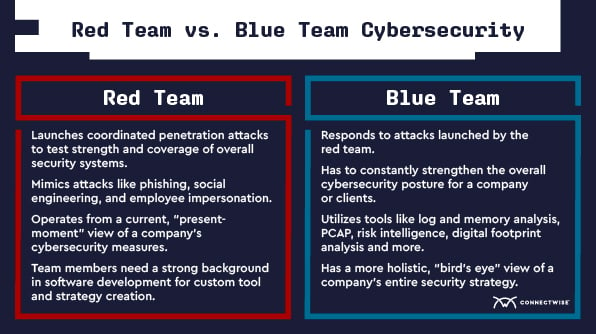Tom Brady. Serena Williams. Tiger Woods. Simone Biles. Christiano Ronaldo. LeBron James. All championship winners in their specific fields, but how did these titans of sport come to dominate their fields? Practice.
Just like a sports team, your cybersecurity team won’t reach its full potential without regular practice. But rather than hitting the gym, cybersecurity teams work out using red team vs. blue team cybersecurity drills.
So how do these drills work? What can managed service providers (MSPs) gain from regularly running red vs. blue exercises?
A healthy practice schedule is vital to the success of your clients’ cybersecurity protection, so read on to learn how to put your security infrastructure to the test.
What is a red team in cybersecurity?
Keeping with the sports analogy, the red team acts as an opposing team’s practice squad. Red teams include ethical hackers, system administrators, and forensic experts who use penetration testing (or “pentesting”) to test the target system’s resilience and look for any potential vulnerabilities malicious attackers could exploit.
The purpose of the red team’s cybersecurity exercises is to test and challenge existing security protocols from an attacker’s point of view.
During an exercise, an IT professional will assume the role of threat actors to see what loopholes or vulnerabilities could pose a major threat by being exploited during a real-world attack. The goal here is not to hold anything back. Successful red team vs. blue team operations require the “practice attacks” to mimic real-world attacks as closely as possible.
With this in mind, many organizations use external actors instead of internal teams to test their systems when conducting red team vs. blue team cybersecurity drills. Bringing in external actors allows organizations to test their systems with fresh eyes and unbiased opinions.
Red team members should be able to:
- Leverage knowledge of software development to develop custom tools effective in infiltrating standard cybersecurity measures.
- Call on previous experience with penetration testing that enables them to test more “under the radar” threat actor tactics, techniques, and procedures (TTPs) that aren’t normally detected or defended against.
- Create clever social engineering attack scenarios that mimic the psychological/emotional manipulation non-IT team members may face in real-world attacks.
- Use their familiarity with computer systems, as well as common security protocols and safeguards, to keep the blue team “on their toes.”
Common red team exercises
Here are a few of the main attack types red team members will employ when testing systems:
- Phishing attacks. These help to test the cybersecurity training of your clients’ non-IT staff. They’ll be made aware of any cybersecurity exposure on the human level, as well as within your email system.
- Social engineering. These are attacks that play on your clients’ team members’ psychology or emotional response. While phishing falls under this category, it may also include more targeted attacks like spear phishing, vishing, whaling, baiting, and more.
- Employee impersonation. Some attacks will come from threat actors who pretend to be employees within the organization. The goal of these attacks is to obtain admin access to sensitive files and information. If not stopped quickly, these types of attacks can be particularly devastating.
Red teams play an integral role in testing the functionality of your clients’ cybersecurity strategy. These exercises provide invaluable data and insights into a system’s effectiveness and are crucial to identifying a system’s vulnerabilities.
What is a blue team in cybersecurity?
If we think of the red team as the attackers in these simulated drills, think of the blue team as the defenders. The blue team is the internal security staff that works to detect, defend, and respond to attacks as they come up.
Blue teams are generally composed of IT professionals, network engineers, and cybersecurity experts tasked with running the cybersecurity infrastructure of the organization. Their job is to ensure the network and systems are secure against malicious activities and threat actors.
The blue team is responsible for reinforcing the cybersecurity posture of their clients on a regular basis. Not only must they be vigilant against attacks from the red team, but they also need to remain alert and aware of any unusual or suspicious activity.
Since members of the blue team are approaching cybersecurity from the defensive perspective, effective blue team members should be able to:
- Take a holistic, bird’s-eye view of the company’s entire security strategy. Their focus should be on people as well as tools.
- Identify and prioritize threat responses accordingly.
- Prevent phishing, domain name system (DNS), and other popular attacks using hardening techniques.
- Show proficiency in monitoring and coordinating the organization’s current cybersecurity tools and threat alerts.
Although both blue and red cybersecurity teams possess their own skills and do their own jobs, cybersecurity is most effective when they work together.
Common blue team exercises
Blue team cybersecurity squads will employ one or more of the following tools:
- Log and memory analysis. IT staff will analyze the information contained in system memory dumps, looking at volatile data and using memory forensics techniques to identify attacks that may not leave a trace on hard drives.
- PCAP. Short for packet capture, PCAP is a method of using third-party application programming interface (API) software to capture packets of data as they enter a network or system. These collections of system traffic data bring valuable insights into file analysis and network monitoring.
- Risk intelligence data analysis. As time goes on and your clients’ systems experience more attack attempts, you should be assembling a running library of risk intelligence. Informed threat intelligence based on hard evidence and actionable insights can better position your team to respond to threats and protect your clients’ company assets.
- Digital footprint analysis. As organizations conduct business, visit websites and share assets online, they leave a digital “paper trail.” Members of your blue cybersecurity team will examine this online footprint and see what steps an organization can take to minimize its size and exposure.
- Distributed denial-of-service (DDoS) testing. In addition to red team cybersecurity attacks, red team vs. blue team cybersecurity drills also run tests against typical DDoS threats. Typically, these are 4- or 7-layer attacks conducted to test the resilience of a network’s service availability.
- Developing risk scenarios. Identifying the specifics of potential attack scenarios is one of the crucial functions of an organization’s defense. Developing detailed descriptions of possible future IT events can be critical in helping you protect your clients from future breaches or interruptions of service.
- Reverse engineering. History is the best teacher. Data from previous attacks and case studies of attacks in similar industries are integral to your security posture. Reviewing past events and asking what went wrong or what you could do better is essential for improving cybersecurity measures.
- Security audits. Regularly scheduled, detailed audits of your clients’ systems help you take a proactive role in their cybersecurity. Routine maintenance tasks like DNS audits ensure the security of data packets being passed back and forth through the system. With so many outside threat actors to worry about, conducting these standard protocols is crucial to using your team’s energy and resources in the best way possible.

Benefits of red and blue teams for cybersecurity
Running regular red team vs. blue team exercises offers a variety of advantages to your cybersecurity posture. They can help you:
- Identify and address system vulnerabilities before malicious hackers can exploit them.
- Understand the most effective strategies to respond quickly to cyberattacks.
- Gain more insight into the potential attack vectors hackers may use to breach your clients’ networks.
- Develop a better understanding of the types of threat actors and malicious activities attackers use.
- Improve communication between security teams, IT staff, and executive management to help accurately assess risk.
Proper blue team cybersecurity helps MSPs gain a holistic cybersecurity perspective. Seeing what loopholes and vulnerabilities your red team can exploit is just one piece of the puzzle. Threat detection and threat response are just as important—if not more important—and blue team cybersecurity measures help strengthen your clients’ systems to that end.
Want to see how these and other tools can boost your cybersecurity efforts? Check out our cybersecurity center for more information.
When should you run red and blue team cybersecurity exercises?
Red team vs. blue team cybersecurity exercises should be a routine component of your security posture. Cybersecurity attacks and threats can go undetected if not tested for, and research shows that the average dwell time for threat actors reached 21 days in 2022. This means that, without red team vs. blue team cybersecurity drills, your clients’ network infrastructure or sensitive customer data is vulnerable to attack.
What is the cybersecurity color wheel?
As the threat landscape has evolved, so has the need for different kinds of cybersecurity teams. To combine these various responsibilities into a single team, the concept of the “cybersecurity color wheel” was born. The goal of the cybersecurity color wheel is to create an integrated security team that goes beyond red and blue team capabilities.
Here are the four additional teams that comprise a full cybersecurity color wheel:
- Green team: A green team is charged with detecting, preventing, and responding to insider threats. It’s responsible for creating policies and procedures to protect the organization from malicious intent by its own employees or contractors.
- Orange team: An orange team focuses on employee awareness training and education. It informs employees about security protocols, teaches them how to spot threats and respond appropriately, and educates them about the consequences of not following security best practices.
- Yellow team: The yellow team builds the infrastructure that a red team can then go in and test. It helps to install the tools, create scripts, and configure systems so that the red team can have a successful test.
- Purple team: The purple team is a combination of the red and blue teams, working closely together to identify weaknesses in an organization’s security posture. It operates on the principle that both red and blue teams need to have an ongoing dialogue to stay on top of emerging threats and technologies.
Cybersecurity’s most valuable players
Red team vs. blue team cybersecurity drills are essential for improving an organization’s security posture. By putting your organization’s security infrastructure to the test, you can find and fix vulnerabilities before they pose a threat.
As an MSP, it’s important to understand the roles and responsibilities of each team in a cybersecurity-colored wheel, as well as when you should be running red team vs. blue team exercises. With the right approach, you can keep your organization well-protected and ready to respond quickly and effectively in the face of any kind of attack.
Equally as important as building effective teams is making sure they have the tools they need to test and address cyber vulnerabilities. Request a live demo of our cybersecurity solutions to see how the ConnectWise cybersecurity suite can help evolve your cybersecurity offerings.

















